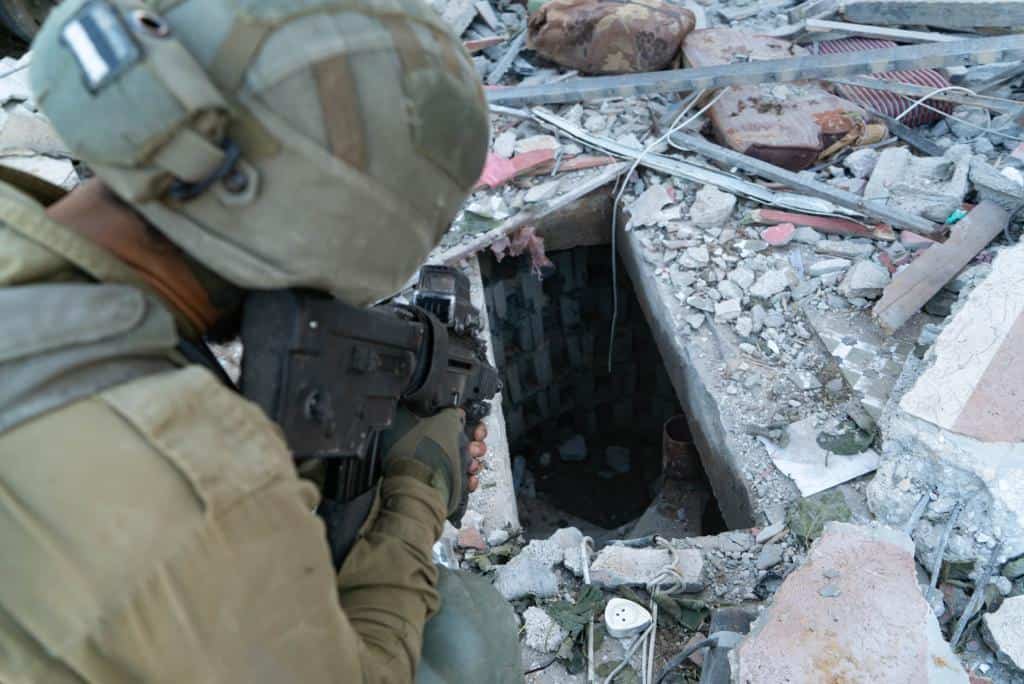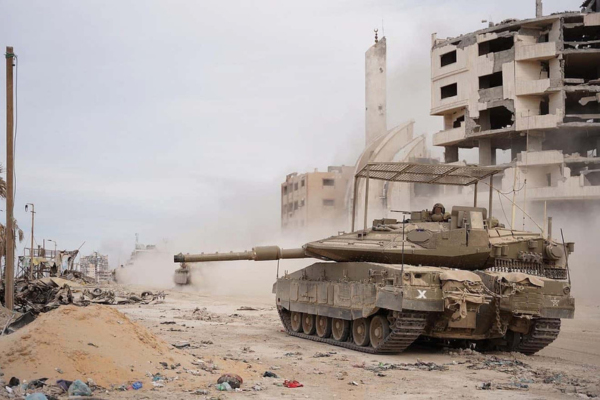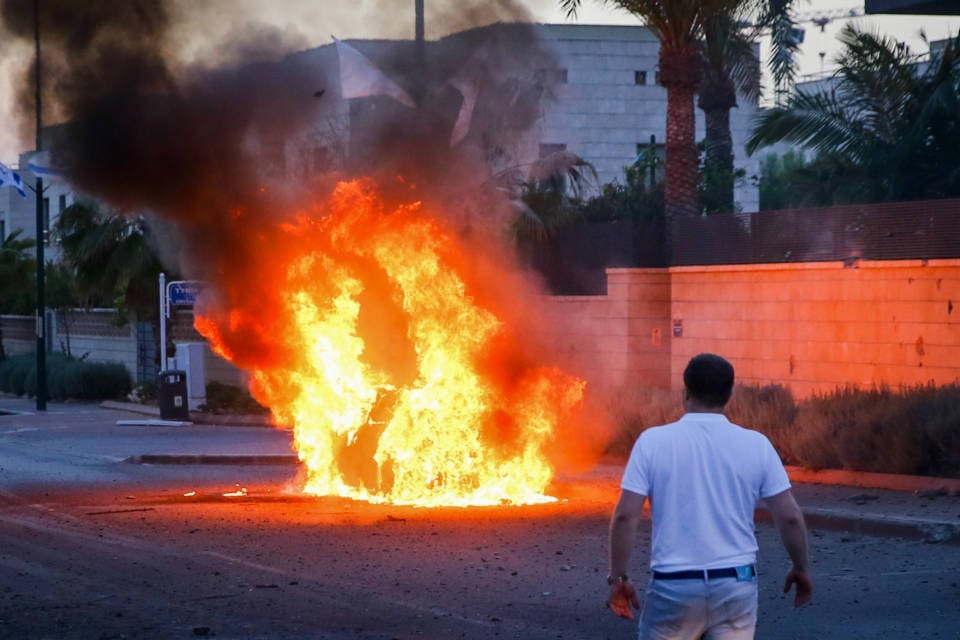The operation sheds further light on how Hamas has turned the civilian infrastructure of Gaza into a weapon of war.
By Yaakov Lappin, JNS
The overnight rescue operation of Israeli hostages Louis Har, 70, and Fernando Marman, 60, on Monday is a critical Israeli mini-success in the depth of Hamas’s last remaining stronghold of Rafah in the southern part of the Gaza Strip.
The level of coordination between the elite Counter-Terrorism Unit, the Navy’s Flotilla 13 commando unit, the Shin Bet intelligence agency and Israel Defense Forces Military Intelligence, as well as the Israeli Air Force that provided close fire support and the 7th Armored Brigade that provided ground support, is testament to a unique degree of Israeli operational capability.
The meticulously planned intelligence was the key enabler of the operation, allowing Israel’s top-tier forces to wait for the right time to move in.
Moving to Hamas’s last bastion is an enormous operational challenge. The ability of the forces to covertly arrive in vehicles, burst into the target building by breaching a blast door and arriving at the second floor where the two hostages were being held represents a significant blow to Hamas’s self-confidence.
Armed terrorists were in the apartment, according to the IDF, and this compounded the fear that the hostages could have been shot on the spot. The combined forces were fast enough to eliminate the terrorists and protect the hostages with their own bodies before extracting them in armored vehicles, under close IAF support and under heavy enemy fire.
It was the good news that the Israeli public had been waiting for after months of bad news. Since the November rescue of captive IDF soldier Ori Magidush, 19, the public has been waiting desperately for more rescues.
The operation sheds further light on how Hamas has turned the civilian infrastructure of Gaza into a weapon of war throughout the 16 years of Hamas rule in the Strip through the use mass use of human shielding, as the hostages were held in an apartment building in the middle of a civilian neighborhood.

Freed Israeli hostages Fernando Simon Marman (left) and Louis Har at Sheba Medical Center in Ramat Gan, Israel. Also pictured kissing Marman is his sister, Gabriela Leimberg, and his other sister and Har’s partner, Clara Marman, on Feb. 12, 2024. Source: X.
The stark reality of urban warfare
The operation occurred under the command of the IDF’s 98th Division, which is spearheading the battles in southern Gaza and is led by Brig. Gen. Dan Goldfuss, who has become a household name in Israel due to his military professionalism, calm leadership, and dedication.
The rescue operation is also a clue about what will make up Israel’s overall victory against Hamas: Not a single dramatic act or a Six-Day-style moment of defeat, but a series of mini-successes that collectively change the situation in Israel’s favor.
This is the guiding logic behind the IDF’s operations as the military moves meticulously and thoroughly ahead through Gaza’s battlefields.
The operation raises larger questions about Israel’s next move in Rafah, which is only a matter of time. It is safe to assume that the IDF has assembled operational plans for this phase of the war, in accordance with the international rules of war—meaning the evacuation of civilians from potential combat zones, just as the IDF has already done with some 1.5 million Gazans.
The IDF Southern Command oversees this elaborate evacuation activity using an array of means to communicate with Gazans and track their evacuation progress. This will be a necessary condition for destroying the remaining Hamas battalions in Rafah.
Throughout it all, the IDF has been contending with the stark reality of urban warfare against an adversary determined to violate all known rules of law to try and gain an advantage.
While the IDF strives to limit civilian casualties, it is also fighting on a battlefield that is rife with unprecedented challenges. These all stem from how Hamas has chosen to entrench its capabilities, operations, communications, headquarters and databases in Gaza’s civilian areas and facilities.
The IDF is setting a new standard for this type of warfare, as John Spencer, chair of Urban Warfare Studies at West Point’s Modern War Institute, has repeatedly confirmed.
“No military in modern history has faced 30k defenders embedded in more than more than 7 cities, using human shields and hundreds of miles of underground networks purposely built under civilian sites while holding hundreds of hostages and launching over +12k rockets at the attacking military’s civilians areas,” Spencer tweeted on Jan. 30.
“Israel has implemented more measures to prevent civilian casualties in urban warfare than any other military in the history of war. This includes many measures the U.S. has (or has not) taken in wars and battles but also many measures no military in the world has ever taken,” he added. “Precautions during the initial air campaign to target enemy military capabilities to include using precision-guided munitions and strict targeting protocols in both pre-planned and dynamic strikes against only military targets.”
Spencer noted that the IDF provides warnings and evacuates urban areas before the full combined air and ground attacks begin.
While this tactic serves to alert the enemy defender and provide them the military advantage to prepare further, “it is one of the best ways to prevent civilian casualties,” he said.
“The U.S. did not do this in the invasion of Iraq or attack of Baghdad in 2003. Did not do this in the 2004 1st Battle of Fallujah but did do this in the Second Battle of Fallujah 6 months later because of the different context. In the 2016-2017 Battle of Mosul, the Iraq government told the civilians to not evacuate and shelter in place during the battle for both eastern and western Mosul, but later changed instructions further into the battle,” he noted.

The 401st Brigade found four tunnel shafts on the outskirts of Jabalia in the Gaza Strip on Nov. 23, 2023. Credit: IDF Spokesperson’s Unit.
Tunnels more in-depth than previously estimated
Israel provided days and then weeks of warnings and time for civilians to evacuate multiple cities in northern Gaza before starting the main air-ground attack on urban areas, he added.
Meanwhile, as the IDF updates its assessment of Hamas’s mind-bogglingly large tunnel network—now reportedly estimated at some 750 kilometers (about 465 miles), some 250 kilometers (155 miles) more than previously estimated—innovative new means are being used to identify and destroy them in line with a tunnel destruction priority list, which begins with Hamas’s most important, strategic underground structures.
It is in such tunnels where Hamas senior leader Yahya Sinwar and his inner circle are hiding now, likely moving from one location to the next using Israeli hostages as human shields.
While the tunnels remain a challenge, they have not stopped the IDF’s momentum. According to Spencer, it represents a major failure by Hamas, which planned for its tunnels to draw in IDF soldiers and units, and paralyze their progress.
Israel at War with Hamas. Support Israel Today!
The people of Israel need your help at this most critical time. Please make a donation to help protect and defend Israelis against unprecedented Hamas terror.
Rockets are falling. Sirens blare, with seconds to run for cover. IDF soldiers risk their lives battling terrorists inside Gaza. Thousands forced to abandon their homes in southern Israel.
To fight terror and save lives, UWI provides bomb shelters, anti-terror vehicles, protective gear, security equipment, medical assistance, relief to victims and much more. Help Israel fight and win this war against Hamas. The time to act is now!




